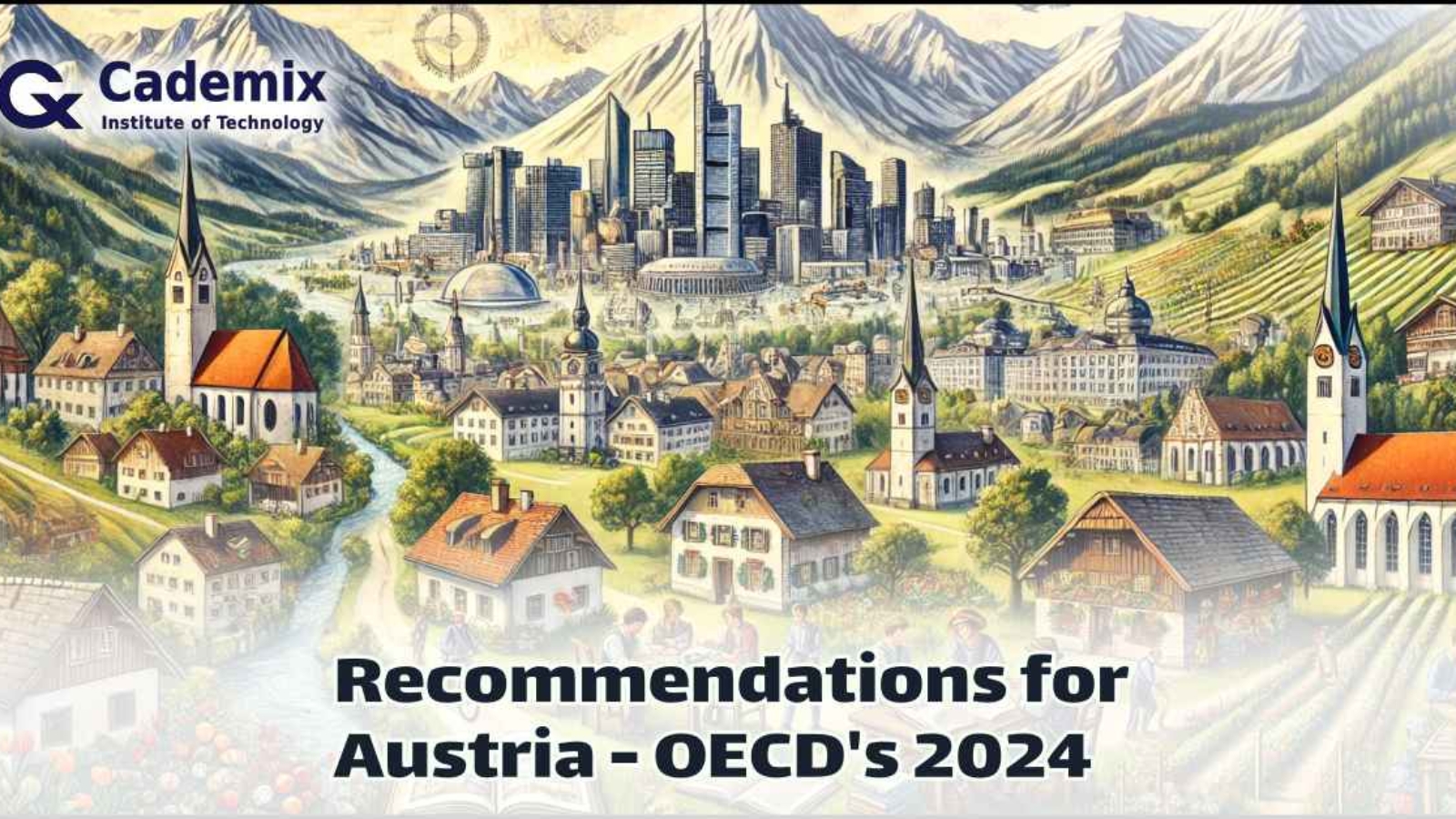In July 2024, the OECD (Organisation for Economic Co-operation and Development) issued a comprehensive report for Austria (OECD’s 2024 Recommendations for Austria), highlighting several areas for reform to create a more growth-friendly tax system and reduce national debt. Key areas identified for reform include pensions, health, climate policy, education, and childcare. Additionally, the report underscores the importance of addressing the shortage of professional workforce, adapting to rapid technological changes, and fostering openness towards international experts.
Dr. Javad Zarbakhsh, Cademix Institute of Technology
Key Points from the Report
- Economic and Social State:
- Austria’s economy has developed well over the last two decades.
- High living standards and relatively low income inequality due to public transfer payments.
- Concerns about high inflation and relatively high national debt.
- Tax System:
- Low property taxes and high labor taxes.
- Recommendation to shift taxes from labor to other bases, such as higher CO2 and property taxes.
- Regular updates of property values for tax purposes.
- Public Debt:
- Concerns over high national debt.
- Suggestion for a mid-term plan to reduce the deficit and debt, leveraging the anticipated economic upswing in 2025.
- Recommendation to link retirement age to life expectancy.
- Health and Preventive Measures:
- Expansion of preventive measures for chronic diseases to reduce health expenditures.
- Climate Policy:
- Higher CO2 taxes, especially in sectors not covered by the EU Emissions Trading System (ETS).
- Replacement of fossil fuel subsidies with targeted support for vulnerable groups.
- Reform of the commuter allowance with social and ecological considerations.
- Childcare and Education:
- Increase in high-quality childcare services to boost female workforce participation.
- Encouragement of balanced parental leave between mothers and fathers.
- Needs-based funding for schools with a high proportion of disadvantaged students.
- Workforce and Technological Adaptation:
- Addressing the shortage of professional workforce by enhancing training and education programs.
- Emphasis on continuing education and acceleration programs to help workers adapt to rapid technological changes.
- Promoting openness towards international experts to fill skill gaps and drive innovation.
Potential Scenarios
- Adoption of Recommendations:
- Positive Impact:
- Improved economic growth due to a more balanced tax system.
- Increased female workforce participation boosting economic productivity.
- Better health outcomes and reduced long-term healthcare costs.
- More sustainable fiscal policy with reduced national debt.
- Enhanced professional workforce through continuing education and international expertise.
- Greater adaptability to technological changes, fostering innovation and competitiveness.
- Challenges:
- Political resistance, especially regarding higher property and CO2 taxes.
- Short-term public discontent with tax reforms.
- Implementation challenges for education and workforce programs.
- Positive Impact:
- Partial Implementation:
- Positive Impact:
- Some economic growth and productivity improvements.
- Gradual reduction in healthcare costs and improved public health.
- Moderate improvements in workforce skill levels and technological adaptability.
- Challenges:
- Limited fiscal improvement if major tax reforms are not adopted.
- Potential inequality if childcare and educational reforms are insufficiently addressed.
- Insufficient response to workforce shortages and technological changes.
- Positive Impact:
- Resistance to Change:
- Negative Impact:
- Continued high national debt and potential fiscal instability.
- Missed opportunities for economic growth and improved productivity.
- Persisting inequalities in childcare and education access.
- Ongoing professional workforce shortages and lagging technological adaptation.
- Political Consequences:
- Increased public frustration with lack of progress.
- Potential political fallout for parties resistant to OECD recommendations.
- Negative Impact:
Importance of Workforce and Technological Adaptation
- Shortage of Professional Workforce:
- Addressing this shortage is crucial for maintaining economic growth and productivity.
- Investment in training and education programs can help meet the demand for skilled workers.
- Example: Programs that offer accelerated learning and certifications tailored to market needs can bridge the skills gap efficiently.
- Rapid Technological Change:
- Adapting to technological advancements is essential for staying competitive in the global market.
- Acceleration programs and continuing education can equip workers with necessary skills.
- Example: Tech boot camps and partnerships with technology companies for hands-on training in emerging technologies.
- Openness towards International Experts:
- Attracting international talent can help bridge skill gaps and foster innovation.
- Policies promoting immigration of skilled workers are vital for economic vitality.
- Example: While Germany has introduced the Chancenkarte (Opportunity Card) for highly skilled professionals, which is more attractive than traditional job seeker visas, Austria needs to develop similar or better pathways to remain competitive.
Germany’s Competitive Edge
Germany has already implemented more straightforward integration and immigration pathways for skilled workers, making it more attractive than Austria for international professionals. The Chancenkarte, for instance, offers a flexible and efficient way for highly skilled workers to enter the German labor market, reducing the complexity and barriers often associated with job seeker visas. This strategic move places Germany ahead of Austria in the competition for global talent.

Role of International Acceleration Centers and Services
Importance of Acceleration Centers
International acceleration centers play a crucial role in addressing the challenges highlighted in the OECD’s recommendations. These centers provide essential support to bridge the gap between the educational system and the job market, particularly in the context of rapid technological advancements and the need for highly skilled professionals. They offer programs designed to equip individuals with the necessary skills and knowledge to succeed in a competitive global market.
Cademix Career Acceleration Program
At Cademix Institute of Technology, we offer comprehensive career acceleration programs, Cademix Career Autopilot, tailored to meet the needs of international job seekers, students, and startup owners. Our programs are specifically designed to support professional integration into the European job market. Key features of our services include:
- Skill Development: Focused training in areas such as technology, engineering, and management to ensure participants are equipped with the latest industry-relevant skills.
- Professional Certification: Providing industry-recognized certifications that enhance the employability of our participants.
- Networking Opportunities: Facilitating connections with industry professionals and potential employers to create opportunities for career advancement.
- Job Market Insights: Offering guidance and insights into the European job market, including job search strategies and application processes.
- Support Services: Assistance with resume writing, interview preparation, and professional branding to enhance the job application process.
- Customized Pathways: Tailored programs that cater to the unique needs of each participant, whether they are seeking employment, looking to advance their careers, or planning to start their own business.
Addressing Workforce Shortages and Technological Adaptation
Through our acceleration programs, we address the shortage of professional workforce and help participants adapt to rapid technological changes. By providing continuing education and fostering openness towards international experts, we contribute to Austria’s economic growth and competitiveness. Our programs are aligned with the OECD’s recommendations, emphasizing the need for a skilled workforce capable of driving innovation and productivity.
Competitive Advantage
In light of Germany’s advancements with the Chancenkarte, Austria must enhance its attractiveness to international skilled workers. Centers like Cademix play a pivotal role in this effort by offering robust support systems and pathways for international professionals. By investing in such acceleration programs, Austria can improve its position in the global competition for talent, ensuring sustainable economic development.
Conclusion – OECD’s 2024 Recommendations for Austria
The OECD’s 2024 recommendations provide a comprehensive roadmap for Austria to enhance its economic growth, social equity, and fiscal sustainability. Incorporating strategies to address workforce shortages, technological changes, and openness towards international experts is essential. Full adoption of these measures could position Austria as a model for sustainable economic policy within the OECD, while partial or non-implementation could hinder potential growth and social progress. Austria must also consider making its immigration pathways more attractive, similar to Germany’s Chancenkarte, to effectively compete for international skilled workers.

